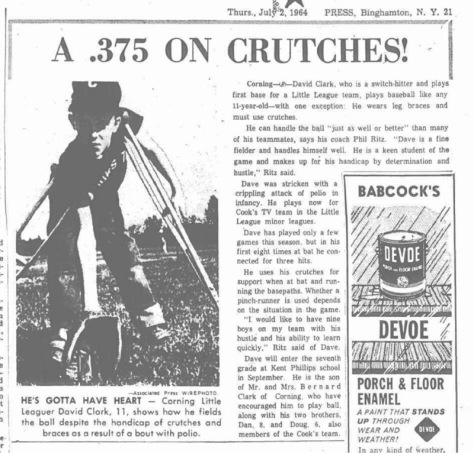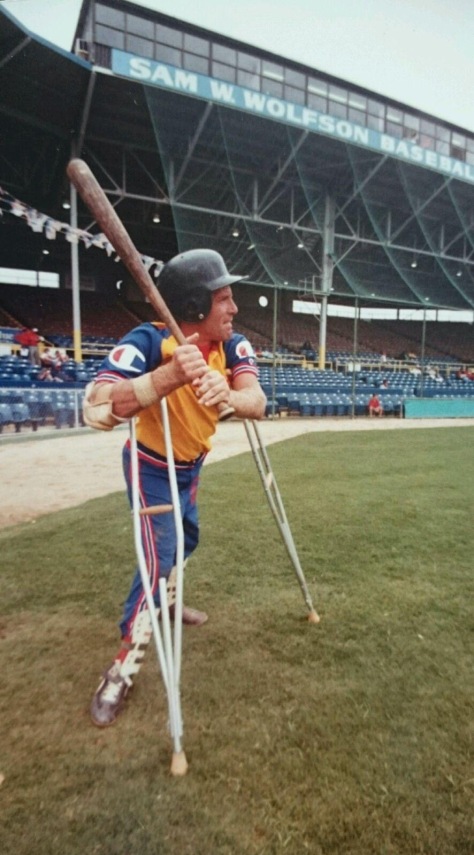
By STEVE KRAH
This is not Dave Clark’s first pandemic.
COVID-19 Coronavirus is impacting the world in 2020.
Clark was born in 1952 and 10 months later he contracted polio, which stunted his growth.
“At that time there was no vaccine,” says Clark. “People were running scared. Parks were closed. Kids were not able to play with each other.
“Someday, hopefully, they’ll have a vaccine for Coronavirus.”
While Clark has had a lifetime of leg braces and crutches, he has not let his situation stop him.
In fact, he figured out how to thrive in spite of it.
Clark grew up in Corning, N.Y., and went on to be a player, coach, scout, and owner in professional baseball.
He played for the Indianapolis Clowns (1975-76) managed by Bill Heward, author of the book, “Some Are Called Clowns: A Season with the Last of the Great Barnstorming Baseball Teams.”
After seeing Clark play at Comiskey Park, Chicago White Sox owner Bill Veeck showed interest in signing the pitcher.
Clark was the final owner of the franchise (1983-88) that traces its origins back to the Negro Leagues. He followed in the footsteps of Clowns owners Syd Pollock, Ed Hamman and George Long. Hamman sold the team to Long of Muscatine, Iowa, in 1972. Long sold the team to Clark and Sal Tombasco of Corning in 1983.
Clark still owns the rights to the Clowns and receives royalty checks for merchandise from the Negro League Baseball Museum in Kansas City.
Knuckle-baller Clark was an all-star pitcher in the Swedish Elite Baseball League, where he later managed, taking a team from worst to first, and winning three major league titles.
While Clark never threw faster than 79 mph, he was a thinker on the mound and rarely walked batters.
Clark has been affiliated with Team USA and the Atlanta Olympics, the Atlanta Braves, and has partnered with the Fort Myers (Fla.) Mighty Mussels (Minnesota Twins Class-A team), Rochester (N.Y.) Red Wings (Twins Triple-A), Binghamton Rumble Ponies (New York Mets Double-A), Nashville (Tenn.) Sounds (Milwaukee Brewers Triple-A) and Elmira (N.Y.) Jackals (ECHL hockey). Clark has been a hockey goalie and also a play-by-play man.
He has been a professional scout for the New York Yankees, Atlanta Braves, Baltimore Orioles, Florida/Miami Marlins, San Diego Padres and Chicago White Sox.
Clark’s awards are numerous. He received the National Giant Steps Award for his coaching, and was honored at the White House by President Bill Clinton. He won the National Heroes of Sports Award in 1999 and the Bo Jackson Courage Award in 2011.
Clark was featured as the keynote speaker at The Family Cafe Conference, and a TedX Conference and has spoken before the U.S. Sports Conference, National Baseball Hall of Fame, Corning Inc., Siemens Energy, and many more.
Besides being a motivational speaker, Clark runs camps for kids with perceived physical and mental limitations. He has been business partners with Doug Cornfield Sr., for a decade.
Clark and Cornfield met two decades ago at Dunn Field in Elmira, N.Y., where Clark was a coach for the Elmira Pioneers.
After a game carrying son Gideon who was born without arms, Cornfield called out to Clark. It wasn’t long before the two met for breakfast.
“I was amazed that I’d never heard of Dave’s story at the time,” says Cornfield, who played basketball and ran track at Taylor University in Upland, Ind., as a freshman before transferring to the University of Georgia. “I peppered Dave with questions.”
But these inquiries weren’t like the ones he’d heard so many times before.
“He talked about his son,” says Clark. “He was speaking as a parent who was concerned about raising a son with no arms.
“He asked what my parents did to let me accomplish what I did. The simple answer: They didn’t hold me back. They didn’t stop me from trying anything I wanted to try.”
Clark says Cornfield helped him to understand how important it is to share his story.
“We need some kind of good news in a world that glamorizes bad news,” says Clark, who now lives in Cape Coral, Fla.
Best Burn Enterprises is the for-profit side of the business and the Dave Clark Foundation the non-profit “which serves to inspire people from all walks of life to overcome personal challenges and perceived limitations in order to lead satisfying and productive lives.”
Clark and Cornfield appeared during the week of Super Bowl LIV in Miami. Scheduled Disability, Dream & Do (D3Day) Baseball Camp stops in 2020 includes partnerships with the Fort Myers (Fla.) Mighty Mussels, Lake Erie Crushers (Avon, Ohio), Hartford (Conn.) Yard Goats, Hickory (N.C.) Crawdads, Binghamton (N.Y.) Rumble Ponies and Hudson Valley Renegades (Fishkill, N.Y.) plus an appearance in Clark’s hometown of Corning, N.Y. Ambassador athlete Dave Stevens, who has no legs, is also a part of the camps.
The events draw around 100 campers per site. It doesn’t cost them or their caregivers a dime. Through fundraising, the cost of the camp, caps, T-shirts, game tickets, and meals for 250-300 are covered.
Clark is always looking for fundraising opportunities and places to speak.
D3Day Baseball Camp was named Minor League Baseball’s 2012 Promotion of the Year runner-up.
A message that Clark shares during the camps is letting kids try anything they want to do.
“If they get a bruised elbow or bruised knew, it’s OK,” says Clark. “You can’t find your potential if you’re not trying something.
“Failure is not trying to do it at all.”
The Indianapolis Clowns traveled all over the country, including stops in Indiana, including Gary, Lebanon, Noblesville, and Jasper.
Clark and Bob Alles of the Jasper Reds have maintained a friendship for more than two decades.
“We had quite a rivalry with the Jasper Reds,” says Clark. “Bob treated us right.”
It was in Jasper that the seed was planted for helping those with physical and mental limitations. Near Ruxer Field there was a residential facility for these folks called Providence Home.
Clark took the Clowns to visit and invited some over to the field for some informal instruction.
When Clark conducts camps with minor league teams, he insists that all the players and coaches participate.
Former Elmira Star-Gazette writer Roger Neumann authored a book about Clark published in 2011 — “Diamond In The Rough: The Dave Clark Story.”
In the forward of the book, Mike Veeck writes “Dave Clark’s story is an astonishing blend of fact and fact. It only reads like fiction.”
Cornfield has penned a children’s book based on a tale from Clark’s childhood entitled “A Pound of Kindness.”
“It’s a true story that happened to me in first grade,” says Clark. “It’s the first time I ever experienced bullying. It’s always been in human society.
“Parents, brothers, neighborhood kids treated me like anybody else. When I got to grade school, I felt that pressure.”
One day, Clark’s teacher announced that the class would be going on a fire station field trip that required a walk of five or six blocks.
With two full-length leg braces and crutches, Clark knew he was sure to slow the class down and he would be a prime target for bullies.
On the day of the field trip, Clark told his mother he was ill and didn’t want to go to school.
“Mom was a fair but tough lady,” says Clark “She knew I wasn’t sick.”
So he went to school but made sure to be in the back of the line.
“Maybe they wouldn’t see I was dragging along,” says Clark.
That’s when classmate Ernie Pound came forward and offered Clark a ride in his red Radio Flyer wagon.
“‘I brought this for you to ride in. Jump in!,’” says Clark of Pound’s words that day. “What was going to be a lousy day turned out to be a great day.
“It’s a story of inclusion. It’s a story of kindness.”
Clark goes into schools and shares that story. Sales of the book — Cornfield is also working on other titles about those with physical or mental limitations based on true stories — help fund the camps.
Cornfield surprised Clark by bringing in Pound to a book signing in 2008 — many decades after that kind day. Cornfield says Clark is too emotional to watch the video of that moment.
There are hopes of making a movie about Clark’s life.
“It’s the greatest mostly unknown sports story,” says Cornfield.
That’s the story of Dave Clark. He’s the one who didn’t let polio stop him from achieving his goals.
“A Pound of Kindness” can be purchased at d3day.com with free shipping using the code: d3day.
During the COVID-19 pandemic, the eBook can be downloaded for free using the code: stay home.
For more information, contact Cornfield at doug@daveclarkbaseball.com or 607-329-0010.

Doug Cornfield (left) and Dave Clark have been business partners for a decade.
 Dave Clark (left), Doug Cornfield and Dave Stevens make appearances all over the country on behalf of those with perceived physical and mental limitations.
Dave Clark (left), Doug Cornfield and Dave Stevens make appearances all over the country on behalf of those with perceived physical and mental limitations.
 Dave Clark, who contracted polio at 10 months, got early attention for his abilities as a baseball player.
Dave Clark, who contracted polio at 10 months, got early attention for his abilities as a baseball player.
 Dave Clark has even taken to the ice as a hockey goalie.
Dave Clark has even taken to the ice as a hockey goalie.
 Dave Clark was affiliated with Team USA Baseball during the 1996 Atlanta Olympics.
Dave Clark was affiliated with Team USA Baseball during the 1996 Atlanta Olympics.
 Dave Clark, using crutches and braces, was a player and owner for the Indianapolis Clowns.
Dave Clark, using crutches and braces, was a player and owner for the Indianapolis Clowns.

Dave Clark waits his turn at the plate as member of the barnstorming Indianapolis Clowns.
 President Bill Clinton (left) presents Dave Clark with the National Giant Steps Award.
President Bill Clinton (left) presents Dave Clark with the National Giant Steps Award.

Dave Clark, who contracted polio at 10 months, was a professional baseball player, coach, scout, and owner. He now tours the country as a motivational speaker.



